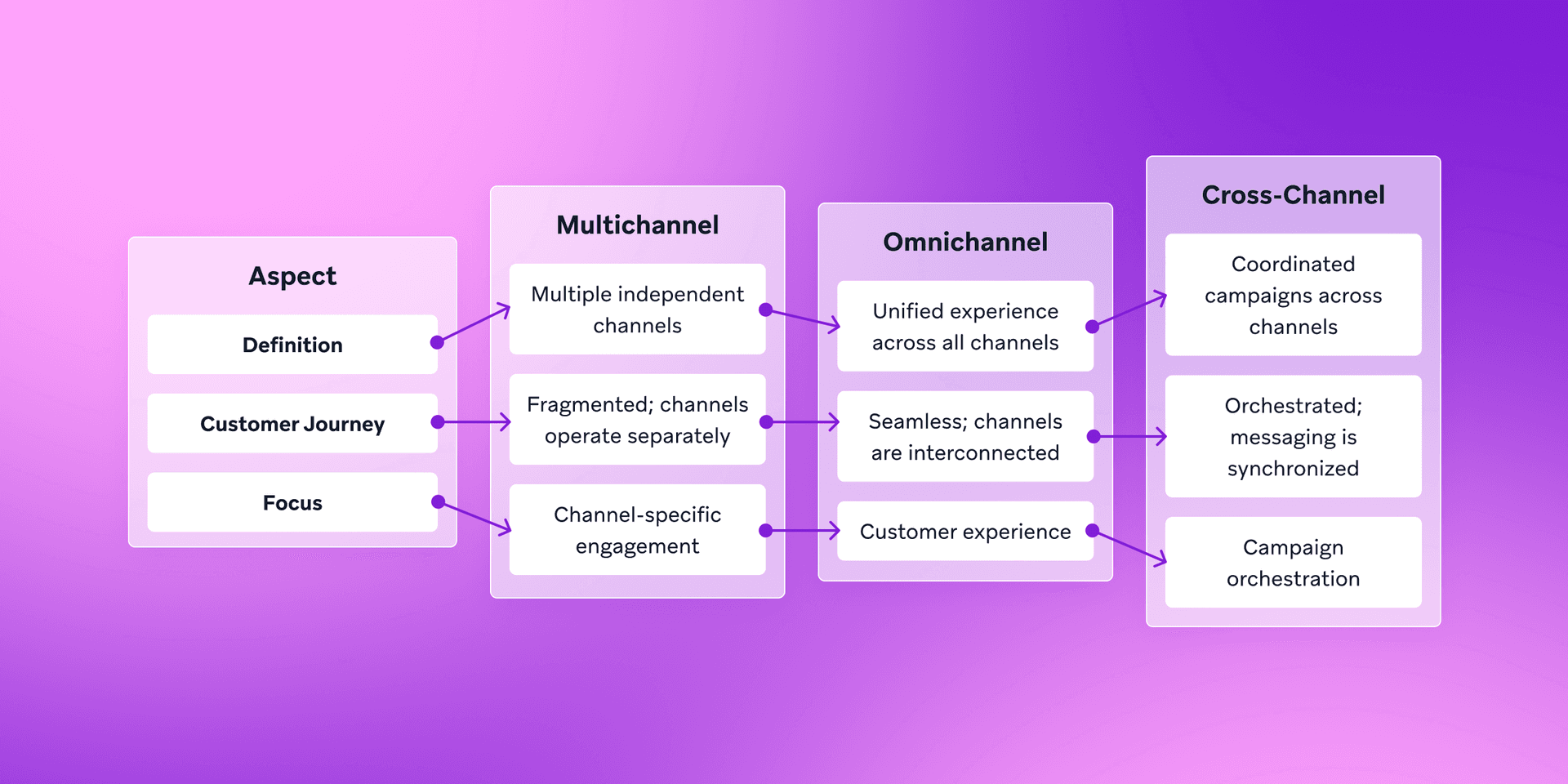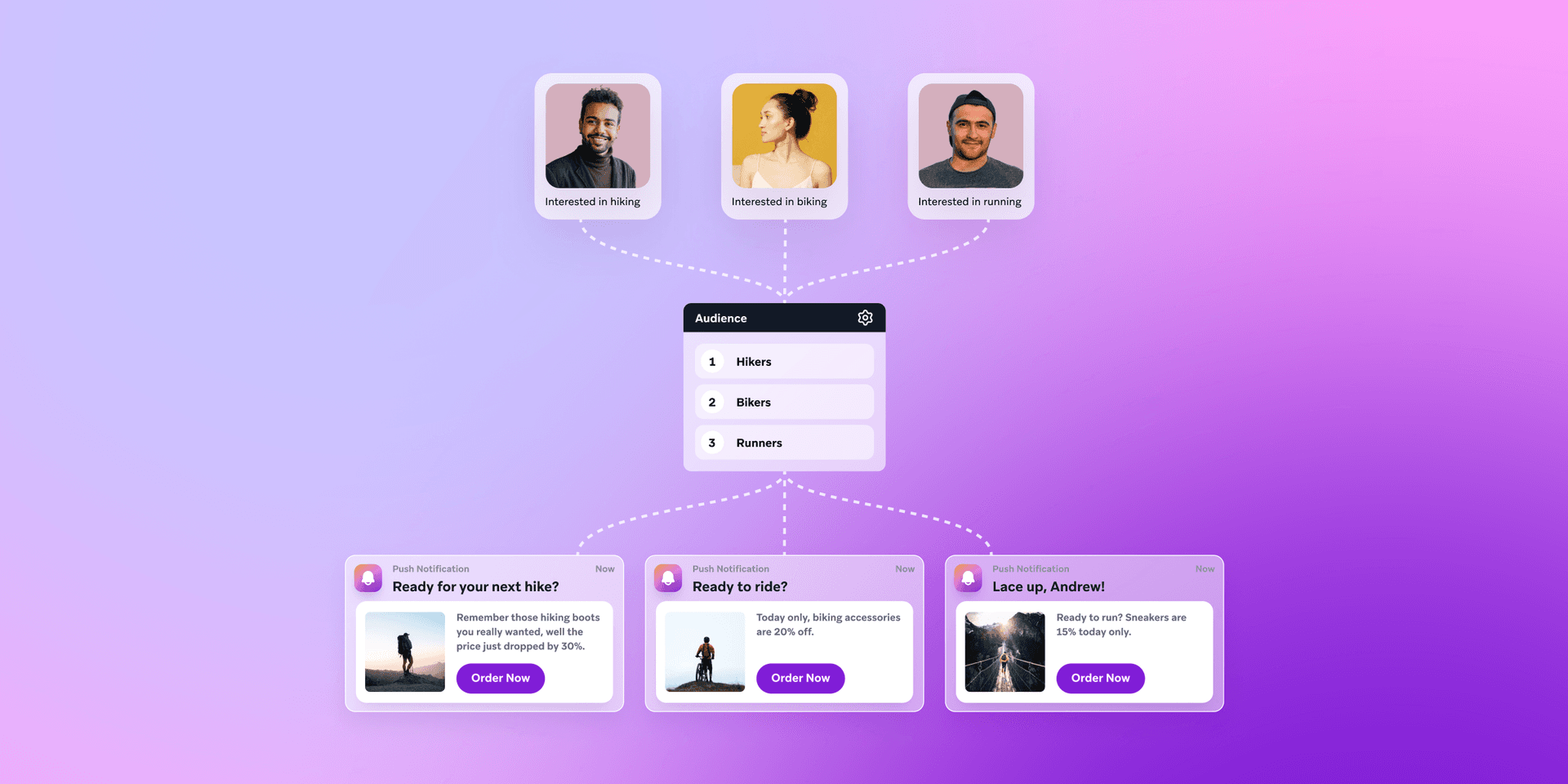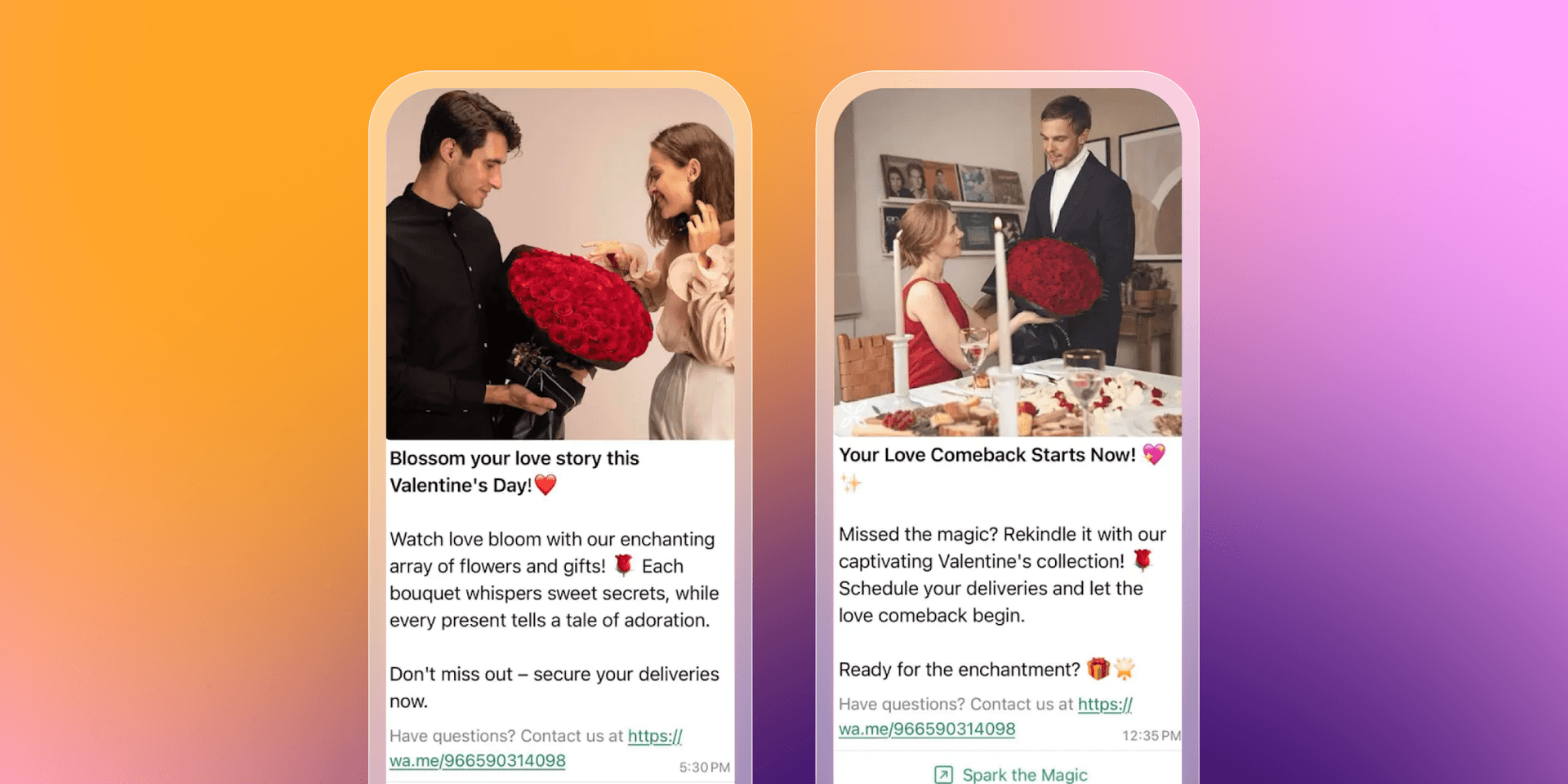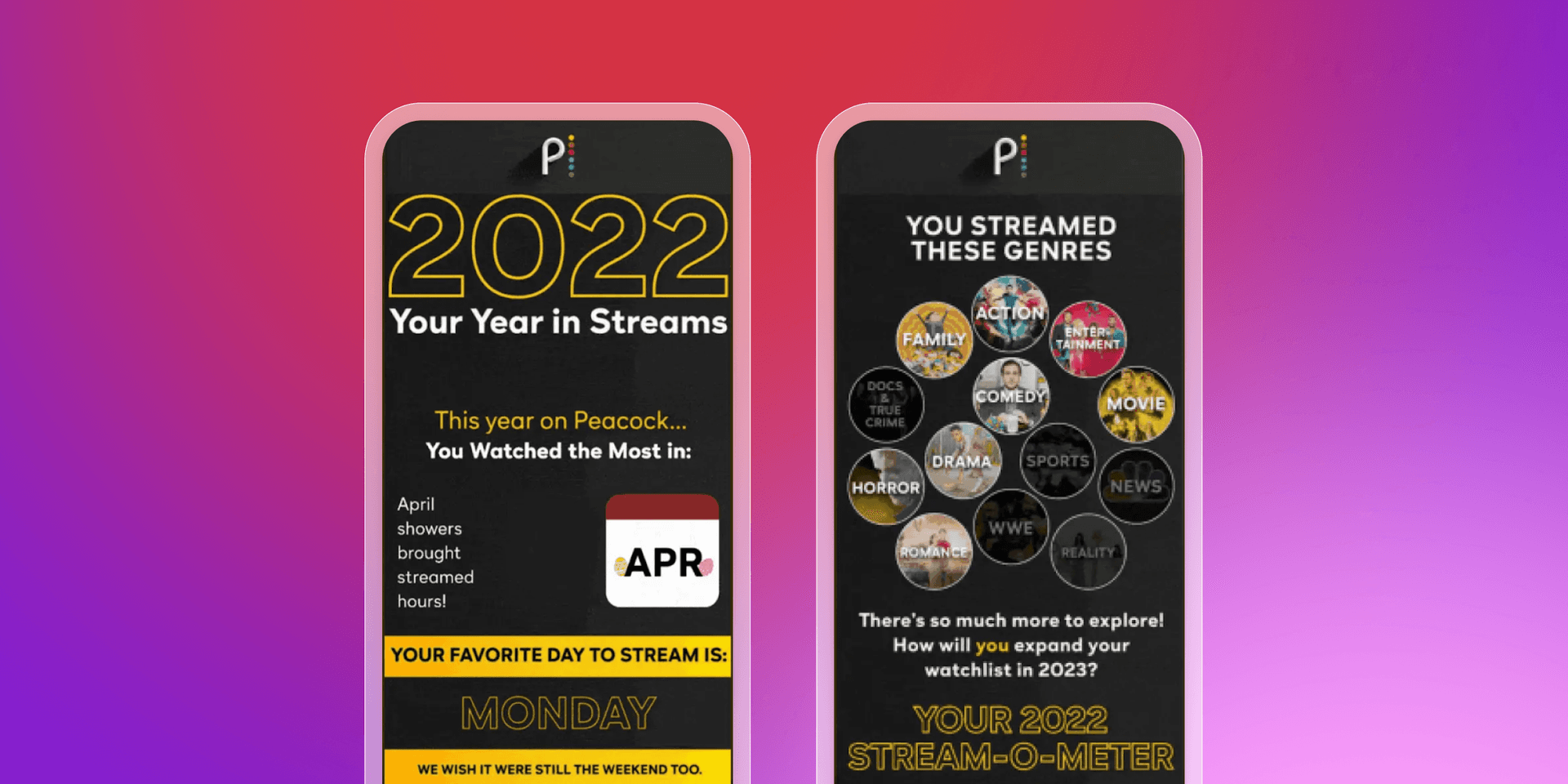What is multichannel marketing? Strategies, examples, and the move toward cross-channel
Published on June 03, 2025/Last edited on June 03, 2025/11 min read


Team Braze
BrazeConsumers are inundated with marketing messages from every conceivable angle, and standing out has become both an art and a science for brands. Picture this: You’re scrolling through your social media feed, and an ad for the perfect pair of running shoes catches your eye. Moments later, your phone buzzes with a text message offering a limited-time discount, followed by an email reminding you of the special offer. This is the power of multichannel marketing—a strategy that not only captures attention but also drives engagement across various platforms.
But what exactly is multichannel marketing, and how does it differ from its omnichannel and cross-channel counterparts? In this article, we’ll dissect the nuances of multichannel marketing, unveil effective strategies, and explore how brands can transition to a more integrated cross-channel approach that resonates with today’s savvy consumers.
In this article, we’ll discover:
- What is multichannel marketing?
- The evolution of multichannel marketing
- Modern strategies to manage channel silos
- How to harmonize your multichannel campaigns
- Adding heart to multichannel marketing
- The benefits of multichannel marketing automation
- Real-world wins
- From multichannel to cross-channel: Your roadmap for success
- Key metrics for multichannel marketing mastery
- Conclusion
- Multichannel marketing FAQs
What is multichannel marketing?
Multichannel marketing refers to the practice of using multiple independent channels to reach and engage customers. These channels can include email, SMS, social media, web, mobile push notifications, and more. The goal is to create a cohesive experience for customers, allowing them to interact with a brand through their preferred channels.
Imagine you’re a customer looking to buy a new laptop. You might see an enticing ad on Instagram, receive an email with a special promotion, and then get a text message reminding you of the limited-time offer. Each of these touchpoints is a separate channel, but they all work together to guide you toward the best laptop for your needs and, ultimately, your making a purchase.
The great debate: Multichannel vs. omnichannel vs. cross-channel
To truly grasp the value of multichannel marketing, it’s essential to understand how it fits into the broader landscape of marketing strategies. Here’s a quick breakdown of how multichannel, omnichannel, and cross-channel marketing differ:

Understanding these distinctions is crucial for marketers looking to optimize their strategies and enhance customer engagement.
Why adopt multichannel? The benefits that make brands shine
Now that we’ve established what multichannel marketing is and how it differs from other strategies, let’s delve into the benefits it offers. Why should brands invest time and resources into a multichannel approach? Here are some compelling reasons:
- Increased reach: By leveraging multiple channels, brands can reach a broader audience. Different customers prefer different channels, and multichannel marketing ensures that you’re meeting them where they are.
- Enhanced customer engagement: Engaging customers through various touchpoints increases the likelihood of interaction. A well-timed email followed by a relevant SMS can keep your brand top-of-mind.
- Data collection: Multichannel marketing allows brands to gather data from various sources, providing insights into customer behavior and preferences. This data can inform future marketing strategies.
- Improved customer experience: When customers can choose how they want to engage with a brand, it enhances their overall experience. A seamless transition between channels can lead to higher satisfaction and loyalty.
A journey through time: The evolution of multichannel marketing
As we explore the benefits of multichannel marketing, it’s important to understand its evolution. How did we arrive at this point, and what historical context shapes our current strategies?
Digital revolution: How channels became our new best friends
The marketing landscape has undergone a seismic shift over the past few decades. In the early days, brands primarily relied on traditional channels like print and television. However, the advent of the internet and mobile technology revolutionized marketing. Brands began to recognize the importance of engaging customers through digital channels. Email marketing became a staple, followed by the rise of social media platforms, SMS marketing, and mobile apps.
This digital transformation opened up new avenues for brands to connect with consumers, but it also introduced challenges—most notably, the risk of creating channel silos.
Breaking down barriers: The challenge of channel silos
As brands adopted multiple channels, they often fell into the trap of creating channel silos. Each channel operated independently, leading to fragmented customer experiences. Customers might receive different messages depending on the channel they engaged with, resulting in confusion and disengagement.
Understanding this challenge is crucial for marketers seeking to implement effective multichannel strategies. The key lies in breaking down these silos and fostering integration across channels.
Tactics for triumph: Modern strategies to manage channel silos
So, how can brands overcome the challenges of channel silos and create a cohesive multichannel experience? Here are some modern tactics that promote integration and collaboration across channels:
- User profile unification: Centralizing customer data is crucial for understanding individual preferences and behaviors. By unifying user profiles, brands can create personalized experiences that resonate with customers.
- AI-enhanced targeting: Leveraging artificial intelligence can help brands analyze customer data and identify patterns. AI can enhance targeting by delivering personalized content to the right audience at the right time.
- Coordinated orchestration through journey orchestration: Tools like Braze Canvas allows brands to design and execute cross-channel campaigns seamlessly. With this tool, marketers can create workflows that guide customers through their journey, ensuring consistent messaging across channels.

These tactics not only enhance customer engagement but also streamline marketing efforts, making it easier for brands to deliver a unified experience.
Seamless integration: How to harmonize your multichannel marketing campaigns
Integrating multichannel campaigns requires a strategic approach. Here are some steps to help you integrate your efforts effectively:
- Define your goals: Clearly outline your campaign objectives. What do you want to achieve through your multichannel efforts? Setting specific goals will guide your strategy.
- Create a content calendar: Develop a content calendar that outlines when and where you will publish content across channels. This ensures consistency and helps you stay organized.
- Coordinate messaging: Ensure that your messaging aligns across channels. While the content may vary based on the platform, the core message should remain consistent.
- Use analytics to inform decisions: Monitor the performance of your campaigns across channels. Use analytics to identify what’s working and what needs adjustment.
By following these steps, brands can create a cohesive multichannel experience that resonates with customers and drives engagement.
The human element: Adding heart to multichannel marketing
While technology plays a significant role in multichannel marketing, the human element is equally important. Personalization is key to creating meaningful connections with customers. Here’s how to inject a human touch into your multichannel efforts:
- Tell stories: People connect with stories. Share customer success stories or anecdotes that highlight how your product or service has made a difference in someone’s life. For example, a fitness brand could share a story about a customer who achieved their health goals using their products, emphasizing the emotional connection to the journey.
- Use conversational language: Avoid jargon and overly formal language. Speak to your audience as if you’re having a conversation with a friend. This makes your brand more relatable and approachable.
- Encourage feedback: Create opportunities for customers to share their thoughts and experiences. Use surveys, social media polls, or direct messages to gather feedback. This not only shows that you value their opinions but also helps you improve your offerings.
- Celebrate milestones: Acknowledge important moments in your customers’ lives, such as birthdays or anniversaries. Sending a personalized message or offer can make them feel special and appreciated.
By incorporating these human elements into your multichannel marketing efforts, you can foster deeper connections with your audience and enhance their overall experience.
The Braze Inspiration Guide is here to help. This collection of 50 inspirational use cases can be easily customized to address your unique challenges.
The benefits of multichannel marketing automation
Multichannel marketing automation is a strategic approach that allows brands to automate campaigns to engage customers across various channels. With the right automation tools, brands can streamline their marketing efforts so that each channel works to deliver a unified experience as customers move through the lifecycle.
By leveraging the right tools to automate multichannel campaigns, brands can deliver personalized content at scale, tailoring messages to resonate with individual customers based on their behaviors and preferences, even as they change. Additionally, automation facilitates timely and relevant communication, allowing brands to send targeted messages triggered by specific actions, such as cart abandonment. Lastly, by automating repetitive tasks, marketing teams can optimize their resources, focusing on strategic initiatives that drive engagement and build lasting customer relationships.
Real-world wins: Case studies of brands making the leap to cross-channel marketing
To illustrate the power of transitioning from multichannel to cross-channel marketing, let’s take a look at some brands that have successfully made this leap. Their stories provide valuable insights into the strategies and tactics that can lead to success.
GoGoX: Logistics that click—Streamlining engagement
GoGoX, a logistics platform, faced challenges in managing customer engagement across multiple channels. By implementing Braze, they unified user profiles and created targeted campaigns that reached customers through their preferred channels. The result? A significant increase in customer retention and engagement.

Floward: Blooming success with personalized messaging
Floward, a flower delivery service, recognized the need for a more integrated approach to customer engagement. By utilizing the Braze platform’s cross-channel capabilities, they crafted personalized messaging that resonated with their audience. This led to improved conversion rates and customer satisfaction.

Peacock: Streaming ahead with coordinated campaigns
Peacock, a streaming service, leveraged Braze to orchestrate campaigns across email, push notifications, and in-app messaging. By delivering consistent messaging and personalized content, they successfully increased subscriptions and user engagement.

These case studies highlight the tangible benefits of adopting a cross-channel approach, demonstrating how brands can enhance customer engagement and drive growth.
Measuring success: Key metrics for multichannel marketing mastery
To gauge the effectiveness of your multichannel marketing efforts, it’s essential to track key performance indicators (KPIs). Here are some important metrics to consider:
- Customer engagement rates: Measure how often customers interact with your content across channels. This includes open rates for emails, click-through rates for ads, and engagement on social media.
- Conversion rates: Track the percentage of customers who take a desired action, such as making a purchase or signing up for a newsletter.
- Customer retention rates: Monitor how many customers return to engage with your brand after their initial interaction. High retention rates indicate successful multichannel strategies.
- Return on investment (ROI): Calculate the ROI for your multichannel campaigns to determine their overall effectiveness and profitability.
- Customer lifetime value (CLV): Understanding the total revenue a customer generates over their lifetime can help you assess the long-term impact of your multichannel marketing efforts.
By measuring these metrics, brands can gain valuable insights into their multichannel marketing performance and make data-driven decisions for future campaigns.
From multichannel to cross-channel: Your roadmap for success
As brands recognize the limitations of multichannel marketing, many are making the shift to cross-channel strategies. But what does this transition entail, and how can brands effectively navigate it?
Steps to success: Transitioning to a cross-channel strategy
- Assess your current strategy: Take stock of your existing multichannel efforts. Identify which channels are performing well and which need improvement. Understanding your current landscape will help you make informed decisions moving forward.
- Make sure you have the right tools: To manage cross-channel marketing effectively, invest in tools that facilitate integration and data sharing. Braze offers solutions that support user profile unification, AI targeting, and campaign orchestration.
- Create a cohesive strategy: Develop a comprehensive marketing strategy that outlines how you will engage customers across channels. Ensure that your messaging aligns with your brand voice and resonates with your target audience.
- Monitor and optimize: Continuously monitor the performance of your cross-channel campaigns. Use analytics to identify areas for improvement and optimize your strategies accordingly.
By following these steps, brands can successfully transition from a multichannel approach to a more integrated cross-channel strategy that enhances customer engagement and drives results.
Conclusion: The future of marketing is multichannel—Are you ready?
As we navigate the complexities of modern marketing, one thing is clear: multichannel marketing is not just a trend; it’s a necessity. Brands that embrace this approach can create richer, more engaging experiences for their customers, ultimately driving loyalty and growth. The shift toward cross-channel strategies is not merely about keeping up with the competition; it’s about setting the pace in an ever-evolving landscape.
As you embark on your multichannel journey, remember that the heart of marketing lies in building relationships. Embrace creativity, tell compelling stories, and prioritize the human touch in your campaigns.
Discover how to make the transition from multichannel to cross-channel marketing by exploring The Cross-Channel Marketing Difference Report.
Multichannel marketing FAQs
multichannel marketing is the practice of using multiple independent channels to reach and engage customers, allowing them to interact with a brand through their preferred platforms, such as email, SMS, social media, and more.
The benefits of multichannel marketing include increased reach, enhanced customer engagement, improved data collection, and a better overall customer experience.
multichannel marketing focuses on using multiple independent channels, while omnichannel marketing creates a unified experience across all channels, and cross-channel marketing emphasizes coordinated campaigns that synchronize messaging across different platforms.
Braze offers a comprehensive suite of tools to manage multichannel marketing effectively, including user profile unification, AI-enhanced targeting, and cross-channel orchestration through Braze Canvas. These features enable brands to create personalized experiences and ensure consistent messaging across various platforms.
To integrate your multichannel campaigns, define your goals, create a content calendar, coordinate messaging, and use analytics to inform decisions.
Related Tags
Be Absolutely Engaging.™
Sign up for regular updates from Braze.
Related Content
View the Blog
How behavioral marketing turns data into personalized experiences

Team Braze

The new inbox reality: How iOS changes are reshaping email marketing

Aparna Prasad

Experience optimization: Turning data insights into better journeys
